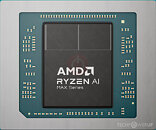T0@st
News Editor
- Joined
- Mar 7, 2023
- Messages
- 3,328 (3.79/day)
- Location
- South East, UK
| System Name | The TPU Typewriter |
|---|---|
| Processor | AMD Ryzen 5 5600 (non-X) |
| Motherboard | GIGABYTE B550M DS3H Micro ATX |
| Cooling | DeepCool AS500 |
| Memory | Kingston Fury Renegade RGB 32 GB (2 x 16 GB) DDR4-3600 CL16 |
| Video Card(s) | PowerColor Radeon RX 7800 XT 16 GB Hellhound OC |
| Storage | Samsung 980 Pro 1 TB M.2-2280 PCIe 4.0 X4 NVME SSD |
| Display(s) | Lenovo Legion Y27q-20 27" QHD IPS monitor |
| Case | GameMax Spark M-ATX (re-badged Jonsbo D30) |
| Audio Device(s) | FiiO K7 Desktop DAC/Amp + Philips Fidelio X3 headphones, or ARTTI T10 Planar IEMs |
| Power Supply | ADATA XPG CORE Reactor 650 W 80+ Gold ATX |
| Mouse | Roccat Kone Pro Air |
| Keyboard | Cooler Master MasterKeys Pro L |
| Software | Windows 10 64-bit Home Edition |
Yesterday, the ASUS Chinese office announced a special event—on February 25—dedicated to launching a next-gen AMD APU-powered premium notebook model: "ROG Magic X (or Illusion X) is the first to be equipped with the Ryzen AI MAX+ three-in-one chip, which can efficiently coordinate multiple modes, provide combat power and computing power on demand, and can handle e-sports, creation and AI with one chip!" The manufacturer's Weibo post has generated plenty of buzz; industry insiders reckon that reviews could be published today (February 18)—HXL/9550pro informed VideoCardz with a not so cryptic message: "STX-Halo NDA: Feb 18th 2025."
Western press outlets point out that the ROG Magic X is a local variant of the familiar ROG Flow Z13 design; a 2025 refresh brings in AMD's much anticipated "Strix Halo" APU design. Team Red-authored marketing material and pre-release evaluation leaks have hinted about impressive integrated graphics solution performance; equalling or even exceeding that of previous-gen dGPUs. Well-known North American hardware review outlets have dropped hints (NDA permitting) about AMD's Ryzen Al Max+ 395 and Max 390 processors. Hardware Canucks could barely contain their excitement regarding the potent Zen 4 and RDNA 3.5 combo package; to the point of wish listing a potential direct successor: "Strix Halo is one of the most exciting things launched into the PC space in the last half decade. Full stop...AMD can't keep this as a one-off. If it's followed up with Zen 6 and RDNA 4 next year...watch out." Naturally, Team Red's cutting-edge mobile CPU technology is arriving in devices with high asking prices. The aforementioned ROG Flow Z13 2025 model—configured with top specs—is priced at $2699. Notebookcheck reckons that ASUS has tacked on an extra $500, since an announcement of initial pricing at CES 2025.




View at TechPowerUp Main Site | Source
Western press outlets point out that the ROG Magic X is a local variant of the familiar ROG Flow Z13 design; a 2025 refresh brings in AMD's much anticipated "Strix Halo" APU design. Team Red-authored marketing material and pre-release evaluation leaks have hinted about impressive integrated graphics solution performance; equalling or even exceeding that of previous-gen dGPUs. Well-known North American hardware review outlets have dropped hints (NDA permitting) about AMD's Ryzen Al Max+ 395 and Max 390 processors. Hardware Canucks could barely contain their excitement regarding the potent Zen 4 and RDNA 3.5 combo package; to the point of wish listing a potential direct successor: "Strix Halo is one of the most exciting things launched into the PC space in the last half decade. Full stop...AMD can't keep this as a one-off. If it's followed up with Zen 6 and RDNA 4 next year...watch out." Naturally, Team Red's cutting-edge mobile CPU technology is arriving in devices with high asking prices. The aforementioned ROG Flow Z13 2025 model—configured with top specs—is priced at $2699. Notebookcheck reckons that ASUS has tacked on an extra $500, since an announcement of initial pricing at CES 2025.




View at TechPowerUp Main Site | Source






